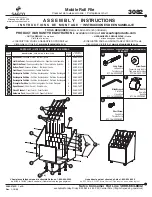
7
—Measure function and statistics—
Twenty-nine waveform
parameters are included
such as: maximum,
minimum, peak-to-peak,
pulse width, period,
frequency, rise/fall time, and
duty ratio. Automated
measurement can be
performed using up to 30 of
these waveform parameters.
Also, waveform parameters
can be measured repeatedly, and the statistical values displayed
(mean, maximum, minimum, standard deviation, etc.).
—Trend and histogram displays—
Waveform parameters such
as period, pulse width, and
amplitude can be measured
repeatedly and displayed in
graphs. In a single screen
you can observe period-by-
period fluctuations, compute
amplitudes every screen
using multiple waveforms,
and display amplitudes as
trends. You can also display
histograms referencing the
voltage or time axis using
values from repeated automated measurement of waveform
parameters.
Displays trends of peak-to-peak or pulse width per cycle
Measures voltage/time differences automatically
—Cursor Measurement—
Cursors can be placed on
the displayed waveform
from signal data, and
various measurement
values at the intersection of
the cursor and waveform
can be displayed. There are
five types of cursor; ΔT, ΔV,
ΔT& ΔV, Marker, Degree
Cursor.
Keeps waveforms with one push
—Snapshot—
By pressing the SNAPSHOT key
to the lower right of the screen,
you can freeze a white trace of
the currently displayed waveform
on the screen. You can press the
key repeatedly and conveniently
leave traces for comparing
multiple waveforms. Also,
snapshot data recorded on
screen can be saved or loaded as
files, and can be recalled for use
as reference waveforms when
making comparisons.
Has a GO/NO-GO function
—Action on trigger—
GO/NO-GO can be determined using
trigger conditions, zone waveforms,
measurement parameters, and other
criteria. For NO-GO, actions can be
carried out at the same time such as
sounding a buzzer, saving the current
waveform, or sending notification to a
designated e-mail address. Waveforms
in which an abnormality occurred can
be saved for confirmation and analysis
of the phenomena at a later time.
Analyzes frequency spectrums
—FFT analysis—
Up to 2 FFT analyses can be
performed simultaneously.
FFT can be performed on
computed waveforms in
addition to the actual
waveforms on CH1 to CH4.
Analysis can be performed
on limited bandwidth
waveforms by filtering,
periodic changes of rotary
objects, and other
phenomena.
Displays stored files in thumbnail format
—Thumbnails of saved files—
Thumbnails of waveform data, waveform image data, and Wave-
Zone files can be displayed. The image and file names are shown
so that you can view screen image contents while copying or
deleting files. A file can be enlarged to confirm the data.
Can check functions with graphical online help
You can view detailed
graphical explanations of
the oscilloscope’s
functions by pressing the
“?” key in the lower left of
the screen. This lets you
get help on functions and
operations on screen
without having to consult
the user’s manual.
Trend display of waveform parameters
Histogram display using the time axis
Simultaneous level and time difference
measurement with the ΔT&ΔV cursor
Using snapshots
(white waveforms)
FFT analysis
Thumbnails of saved files
Thumbnail can be viewed full-size
tility
Range of functions that help operation efficiency
U
“SNAP SHOT”
key
Abnormal waveform detected
Action specified
for NO-GO
Buzzer
Output
to printer
Save waveform
data file
transmission





























